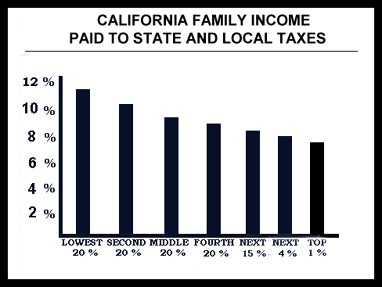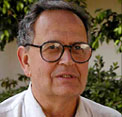| | | | | |
|
 |
THE SOLUTION TO CALIFORNIAS
BUDGET
CRISIS REQUIRES:
A FAIR TAX AND FISCAL RESPONSIBILITY
INTRODUCTION
The budget crisis in California is quite peculiar. Over the last five years, we saw the highest state income ever in California history. Income poured into the state at a growth rate three times greater than the norm.
Typically, California has needed a general fund growth rate of between 3.5% and 6% per year to maintain a balanced budget. During the Gray Davis era, income grew at no less than 10.07% per year, compounded. Gray Davis served through the easiest era in recent history for a governor to maintain a balanced budget. In fact, California should be sitting on a substantial surplus. Instead it has a massive budget gap, reported to be as large as 38.2 billion dollars.
Governor Davis and his financial team increased spending at a compounded rate of 14.85% per year. This assumes the gap of 38.2 billion and that the general fund must absorb the increased expenditures. At the same time Davis and his financial team helped cut taxes for the wealthier Californians. He spent and projected future spending at an unsustainable rate, and instead of seeking new sources to cover these expenditures, he sought to lower taxes. This set our state up for the fiscal disaster we are now living through.
The level of incompetence and fiscal irresponsibility displayed by the Governor is truly remarkable.
CUT BACKS
Large cut backs are now being made in education, health care, and in important social services for the elderly, children, handicapped and others. Many of these services existed in 1997 before Davis became governor, during the time that the general fund received 48 billion in income. Now with an income of 63 billion, these programs are being cut.
A FAIR TAX IS THE ONLY ANSWER
While waste and inefficiency need to be eliminated, the main issue in this electoral campaign and in the budget discussion is the question of taxes.
The Camejo campaign is determined to inform voters of the truth of Californias
tax structure. That is this: The poor pay a higher tax rate than the rich (see
chart below).
The
budget deficit can be eliminated with a FAIR TAX, one in which the wealthiest
people would pay at least what the average person is paying.
This is the only reasonable, intelligent and beneficial solution for the present
crisis. This FAIR TAX concept is the centerpiece of our campaign.

BASIC TAX FACTS
The income of the richest 5% in California has risen 113% since 1993 while their tax rate has declined. The average person in California has only made a small income gain adjusted for inflation. Latinos have actually had their income decline slightly (3%), while their tax rates increased. If the richest 5% paid the same tax rate that the poorest 20% pay in California there would be a substantial surplus in our budget allowing for innovative programs to help stimulate the economy.
Corporations 20 years ago paid 14% of our state tax income but today they pay only 7%.
California is 20th in the nation in state taxes per person. Republican-run states such as Utah, Wyoming and Arizona have higher tax rates!
California is 36th in property taxes. Proposition 13th has created a drop in taxes for corporations and has led to all kinds of unexpected consequences. It creates higher taxes for first-time homebuyers. It prevents many long-term residents from moving, lest they suffer a sharp property tax increase. It results in billionaires like Warren Buffet paying a one tenth of one percent tax rate on multi million dollar homes while many working people pay more than 10 times this rate.
NON-PARTISAN AUDIT
On June 30th 2003 Camejo called for a nonpartisan comprehensive audit of the last five years in order to better understand how this budget disaster occurred and to help identify waste and corruption. The goal of the audit would be to develop comprehensive ideas for preventing a future crisis. The audit may suggest the establishment of a permanent non-partisan investigative body to make recommendations to the Governor and legislature. This body could make unannounced audits of state departments.
There are some indications that money was wasted as favors for political contributors,
such as the Oracle deal in which over $90 million in purchases were made of apparently
unneeded software. More recently, the Camejo campaign exposed a giveaway by Davis
of $6.4 million in taxpayers money to a corporation. The money was disguised
as funds for re-training of workers when no re-training exists.
INTIATE SPECIAL PROGRAMS TO STIMULATE THE ECONOMY
Today we are presenting a comprehensive plan to promote solar energy in California. Our goal is to turn California into the technology leader in renewable energy. This will create jobs and lower the cost of energy, thus stimulating, protecting and stabilizing the economy. We present this plan as an example of how the state government can work to make a difference in the well being of the economy and the people of California.
We are also supporting Sheila Kuehls bill for a single payer health care
system. The independent analysis of the Lewin Group adopted by the state of California
indicates that total savings to Californians of a single-payer health care system
are $3.7-$7.6 Billion per year. The savings is not entirely state savings; it
is split roughly 50/50 between the state and the private sector. Still, this
means that adopting single payer can save the state up to $4 Billion next year.
The Green Watchdog report for California which is a report of Friends of the Earth, the California Tax Reform Association, Green Capitol, and CALPIRG, with the support of 16 other major environmental organizations lists
fourteen program cuts and changes in policy that responsibly address environmental
crisis while increasing social equity. These programs include, among a dozen
other suggestions:
- Eliminating special tax breaks for oil companies
- Eliminating the loophole in Proposition 13 that allows corporate-owned property
to be taxed at significantly lower rates than peoples homes.
- Eliminating pork barrel spending on large, environmentally destructive construction projects.
These proposals would save California approximately $4.6 billion this year and $23 billion over five years.
These three proposals are not included in the chart of specific proposals below.

Appendix
CRUZ BUSTAMANTES BUDGET PLAN
Cruz Bustamante has presented a comprehensive budget plan. As such he is the only replacement candidate in the recall campaign to do so. Given that the Bustamante campaign has much larger resources than the Green Party, we feel it is of value to outline to the press our reaction to his proposals. We want to focus both on the areas that we agree with and disagree with in his plan.
In the Bustamante plan, we agree with:
- The proposal to reassess commercial property. Add 2.9 billion
- The increase in income tax on the wealthy, but at larger amounts (as stated above).
- The proposals on closing loopholes.
- Raising taxes on tobacco and alcohol, with a caveat explained below.
- Bustamante and Ueberroths plan for a tax amnesty to generate additional
revenues.
- Efforts to eliminate fraudulent activity in Medical.
- Increasing health care coverage for 5 million workers. We differ on how to go about this.
- Support of SB 614, the Cedillo bill against tax shelters, and SB2 which seeks to limit corporate use of taxpayer funds through food stamps and welfare benefits, in place of paying a living wage.
- No increase in community college fees.
In the Bustamante plan, we disagree with:
- Bustamantes plan does not refer at all to the existing cutbacks in education.
We seek to end all of these cut backs and re-institute the funding.
- Similarly, Bustamante does not refer to cutbacks in health care and other programs in which massive numbers of people are losing key services (550,000 people), as well as partial cutbacks in endless numbers of programs. These cutbacks are outlined by the California Budget Project
- We would seek to reinstate all such programs after a careful review.
- We disagree with the amount of increase in the taxes for the wealthy. Bustamantes
figures are too modest and would leave the budget well short of needed funds.
- Bustamantes plan does not reduce taxes for the lower income 60% of Californians.
Reducing these taxes, when combined with certain tax increases for the wealthiest
20%, would achieve a FAIR TAX for everyone.
- Tobacco taxes have been continuously raised but they should not be used for general
purposes. That makes the state a partner in the promotion of an addictive drug.
Such funds should be targeted only for health care and to end drug addiction.
Also we disagree with Bustamantes position that people can choose not to smoke. Almost all people who smoke want to stop but cant.
If we continue to raise taxes on tobacco, eventually we will create a criminal
world that will provide the addictive drug at lower prices. Then the result becomes
tax-negative as is our current criminalization of other plants.
- Bustamante fails to refer to the explosion in spending on prisons, which has risen from 3% of the budget to 12%. We want to create a comprehensive program to begin lowering the prison population and closing prisons, as well as lowering the overall costs.
- Bustamante did not refer to the increase in student fees in the U.C. system. We would seek to return these fees to much lower levels.
- We favor a single payer health care system, which would generate 4 billion in savings for the State of California.
|
|
|





